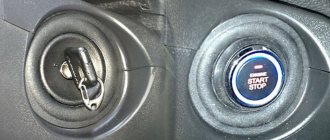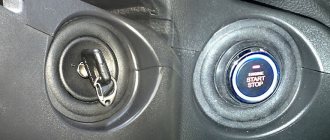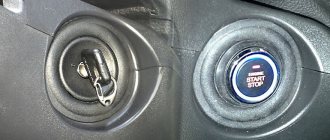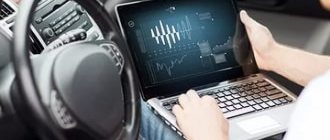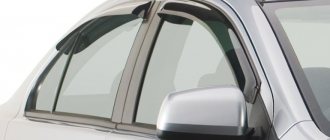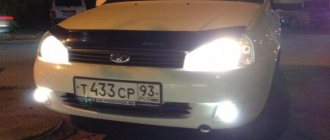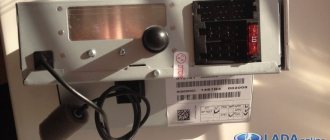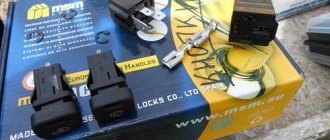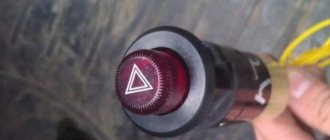In many recent car models, a button is used to start the engine instead of the usual key. How much better and more convenient it is - everyone determines in accordance with their preferences. The appearance of such a new product has caused many drivers to want to install a push-button engine start on their old cars. Therefore, it would be quite appropriate to consider how the ignition and engine starting system can be redesigned in accordance with new trends.
Why is this necessary?
The reasons can be very diverse:
- changed (simplified) engine starting process;
- reducing the number of items in pockets;
- the desire to stand out and many others.
It is best to leave aside attempts to figure out why such a desire arises and understand how to install a button to start the engine (in further text it may be referred to as Start-Stop Engine or abbreviated SSE).
Engine starting system with a button, options for its implementation
It should be noted right away that there are quite a lot of options for connecting the button. This is due to the fact that such a system can be built taking into account a wide variety of initial conditions. As an example, below are some options for how to install such an element, possible operation algorithms of the Start-Stop Engine and the components used. Which one to choose is up to you. If the level of knowledge of electronics and circuits is high enough, you can make your own based on any of the options, you just need to understand the principle.
How the ignition key can be used:
- the key is inserted into the lock, set to position I, and then, after pressing the button, the engine starts (the key allows you to remove the steering wheel lock, which is available on many cars of the VAZ family);
- the key is not used at all, got into the car - pressed Start-Stop Engine, and the engine started.
- What buttons can be used, their installation, connection diagram:
- without locking, in this case it must be pressed and held until the engine starts;
- with fixation, pressed and released, the beginning of stable operation of the motor will be detected by the electronics and the starter will be turned off.
How the ignition system works:
- its start is carried out separately from starting the engine (pressing Start-Stop Engine turns on the ignition, then presses the brake or clutch again and the engine starts);
- the ignition starts working simultaneously with the engine starting;
- Various blocking of the Start-Stop Engine and ignition is carried out, including (the blocking scheme may involve the use of a signal from a security alarm, an open door sensor, turning on the dimensions, etc.).
These are just some of the possible options and algorithms that allow you to start the engine without a key in the car lock.
Audi A6 C.C.O. › Logbook › Start-Stop system and its features
As you remember, readers, my car has a start-stop system - which is a unique and amazing feature of the car, because not every car stalls at traffic lights!
And so I was puzzled by this question and started looking for information and testing. There are certain conditions under which the system does not work, there are certain protections, and there are certain tricks, but more on that later! After googling, I came across both the story and the principle of operation - it’s interesting, I’ll tell you, so, pay attention, everything is in order.
In general, what is this “Start-Stop”:
The Stop-Start system is designed to save fuel, reduce emissions and reduce noise by reducing engine idling time. As car operating practice shows, idle mode accounts for up to 30% of the total engine operating time. This is facilitated by frequent stops at traffic lights, being stuck in traffic jams and possibly waiting in a car for someone at the entrance. In your own words - get stuck in traffic jams for free, because both the climate system and the music work!
History of creation:
As for history, this is also interesting, I’ll just give an excerpt from the article dpgo.ru/article/2012-02-1…printsip-raboty-problemy-
How it works:
The principle of operation is to turn off the engine when the car is stopped and quickly start it when you press the brake pedal.
Structurally, the Stop-Start system includes the following elements: - a device that ensures repeated engine starting; - control system. There are several approaches to implementing the multiple engine start function:
- reinforced starter; — reversible generator (starter-generator); — fuel injection into the cylinders and ignition of the mixture. The simplest and most reliable in terms of design is the Stop&Start system from Bosch. Thanks to this system, the name “stop-start” has become a common name for other systems. The Stop&Start system is installed on Audi cars and reduces fuel consumption and harmful emissions by up to 8%.
The basis of the system is a special starter
, designed for a large number of engine starts and having an extended service life. The starter is equipped with a reinforced low-noise drive mechanism, guaranteeing fast, reliable and silent engine starting.
The control system performs the following functions:
— stopping the engine; - engine starting; — battery charge control. Like all modern electronic control systems, the Stop&Start control system includes: - input sensors; - Control block; - actuators. Input sensors include the engine speed sensor, clutch pedal position sensor (brake pedal position sensor), battery sensor, and other engine management system sensors.
The system does not have its own electronic unit, but uses the power of the engine control unit, where the corresponding software is installed.
The actuators of the system are: — nozzles of the injection system; — ignition coils of the ignition system; — starter.
The Stop&Start system works as follows:
When the car stops at a traffic light or in a traffic jam, the system, based on the signal from the crankshaft speed sensor, stops the engine. Electrical consumers (air conditioning, audio systems, etc.) are powered from a battery. When you release the brake pedal on the car, the system activates the starter and starts the engine. Subsequently, the cycle of stopping and starting the engine continues.
If the battery charge level drops below a preset value, the system turns off based on the signal from the corresponding sensor. The system is turned on after charging the battery. The system can be forcibly disabled using a special button on the instrument panel.
The trick is also the reversible generator, which is an alternating current electrical machine that can act as a generator and starter depending on conditions. The operation of the reversible generator is ensured by a special drive belt and a reversible tensioner, which allows force to be transmitted in two directions. The reversible generator operates silently and has a shorter starting time (0.4 s compared to 0.8 s for a conventional starter). Therefore, starting at a traffic light occurs almost imperceptibly.
Required working conditions
The start-stop system only operates at speeds above 4 km/h, with the driver's door closed and the driver wearing a seat belt, as well as other parameters that may be specified by the manufacturer.
In addition, the system will not turn on when the car is not warmed up (this also includes a discrepancy between the engine speed and idle speed), if the heated windows, mirrors and other elements are turned on, the generator is faulty or the battery charge level is below normal, the stop occurred after turning off the rear travel or the steering wheel is turned to a large angle (for example, for parking maneuvers). This is all yes, and at first I thought that if these conditions were not met, the car could only be turned off manually, but no, there are options:
- movement, door, cold car, as well as the battery charge level and discrepancy in rotation speed for any reason - this is invincible; — after moving backwards, the system does not work, everything is simple: you turn off the parking sensors after stopping and the “A off” button clicks and stalls; — the wheel is turned out, and the system does not work, well, it’s generally not very good to turn off the car with the wheel turned out, because the hydraulic system turns off, and there are opinions that this is not safe for it, the principle is the same: you twist the steering wheel until the wheels are straight and press the brake pedal harder; — I didn’t notice the heated mirrors and windows, but in the heat, when the climate control is turned on, the car stalls only when the temperature in the cabin is comfortable; - in general, if the system does not work, you should click “A off” and you will be happy!
They made, in principle, the correct conclusion: “THE START-STOP SYSTEM SAVES FUEL ONLY WHEN THE CAR MOVES THROUGH A HALF-EMPTY CITY AND STOPS BRIEFLY AT TRAFFIC LIGHTS. IN PROLONGED TRAFFIC TRAFFIC TRAFFICS THIS ELECTRONIC ASSISTANT GIVES ALMOST NO GAIN.”
This is actually true - in traffic jams the savings are not so great when you move a teaspoon per hour, but in general it really helps to save money, otherwise how can you explain that a huge business class sedan eats like a small car!
My conclusion:
the system is good, necessary, useful - this is our future! Saves fuel!
Poll at the end:
who has? Who uses it? Who thinks about this?
I hope I didn’t bore you, thank you for your attention! The “like” and “tell” buttons are relevant!
Source
How to make such a launch possible
As an example, several options for implementing such an idea are considered below. It is worth considering that when undertaking such a modernization, you need to understand and understand what and how to do, because you carry out all manipulations at your own peril and risk. If during the work you have doubts about the correctness of the actions, you should seek advice from a specialist (auto electrician).
Scheme of starting an engine from a button using a key
There are a significant number of different options for implementing this approach. For example, the diagram below.
And below is a diagram of connecting the relay to the ignition switch
Everything works extremely simply. The key is inserted into the lock and turned. Then the button is pressed and held until the motor starts. To turn off the entire system, simply turn the key to its original position. With this option, all functions of the ignition switch and immobilizer are retained.
Installing an engine start button without an ignition key
This is a more complex option that allows you to start the engine using a button; this approach uses, for example, RZPTF (rear fog lamp relay). Its activation is shown in the diagram shown in the figure:
An additional advantage will be connecting power to the alarm system. In this case, the operating algorithm will be as follows:
- the car is removed from the alarm system, power is supplied to pin 1 of the RZPTF, and the backlight turns on;
- the button is pressed and held - the ignition and starter relays are turned on, the starter begins to spin;
- the button is held until the engine starts, then it is released, the starter relay is turned off, the engine continues to run;
- pressing again stops the engine;
- After setting the car to the alarm system, the backlight goes out.
This is one of the possible ways to implement such a launch system. During such a launch, other elements can be used. For example, the engine will start when you press the clutch or brake, everything will be determined by the specified starting algorithm.
The idea of starting the engine using a button instead of a key is possible on any car. In this case, a completely arbitrary algorithm of action can be used. The decision on how to start the engine - with a button or with the ignition key - is a matter of personal choice and the skill of the person who will undertake the modification of the ignition system. » alt=»»>
Problems with keyless car starting system
As noted earlier, the use of such a system is associated with a number of problems. Most of them cause inconvenience only in the absence of certain skills in using the presented system.
This may include:
How to unlock the steering wheel
Another important problem that motorists who have equipped their cars with such a system often face is unlocking the steering wheel. Of course, as a last resort, you can resort to a barbaric method and get rid of the blockage using simple manipulations with a mounting tool and other tools.
You can solve this problem as follows:
But it’s still much easier to use the services of professionals. The fact is that it is not always possible to unlock the steering wheel yourself, due to the characteristics of a particular car. Therefore, in this case, it is best to contact specialists.
How the start/stop button works
The start/stop device operates on the simplest principle: first, the car alarm is turned off, then the driver depresses the brake pedal, then presses the button.
Car-installed start/stop button
The starter operates for one or two seconds, after which the car starts. If the engine needs to be turned off, the driver again squeezes the brakes all the way and clicks the button.
Advantages and disadvantages of the device
First, we list the advantages of the “start/stop” mechanism:
- The driver no longer needs to use the ignition key every time he needs to start the engine. All it takes is a simple click;
- you can mount the “start/stop” anywhere. This means the car will become a little more comfortable;
- there are special schemes in which the start/stop button is connected to the immobilizer or alarm system, which is an additional security measure that prevents car theft;
The start/stop button can be linked to your car's alarm or immobilizer
But there were some downsides too:
- To start the engine, the driver must sit in the car and press the brakes. Getting used to this feature of starting the engine can be difficult, especially for novice car enthusiasts;
- if the driver decides to install an alarm with an auto-start function on a car with a button (to warm up the car in winter, for example), then problems may arise with this, which, fortunately, can be solved. The driver will just need to have a couple of key fobs with him. One of them will have to be given to alarm installers so that they can disassemble it, take out the microcircuit and put it in the car. After this, the current will be supplied only at the moment the engine starts. But for all this, the car owner will have to seriously pay extra to the craftsmen;
- If a button is already installed on the car, but there is no alarm yet, then installing it will cost the driver more, sometimes twice as much.
Start Stop system: pros and cons
The “Start Stop” buttons are being improved, but they still have shortcomings that are difficult to eliminate. Therefore, some car enthusiasts consider buttons to be a useless addition, believing that their disadvantages completely cancel out their advantages. First, about the benefits.
Whatever you say, start-stop really helps reduce fuel consumption. Savings can be 10%. This is a real “must-have” for those who constantly drive within the city with its traffic jams and traffic lights.
We must not forget about the environmental component. When the engine is running, a lot of harmful substances are generated and released into the atmosphere - using Start-Stop reduces the amount of emissions.
While sitting in a traffic jam, the engine will not work. Therefore, there will be no noise from it. The load on engine parts and the crankshaft is reduced.
And now about the cons. The main one is an increase in load on the battery and starter, which can lead to their breakdown. To start a car, you first need to press the brake, and some car enthusiasts forget to do this.
If you need to install an alarm on a car with a button, be prepared for the installation to be expensive. If there is a button, you will have to install a reinforced starter, but it is not cheap. Real fuel savings will only be achieved when driving from one traffic light to another - "Start Stop" loses its effectiveness when you have to move jerkily in large traffic jams. In this case, the starter operates frequently, which leads to a decrease in battery charge. It takes time to replenish, and there is never enough of it. Because of this, the system automatically shuts down.
The developers are constantly improving Stop & Start - we hope that in the near future its disadvantages will be minimized. The number of car models with such a system is multiplying in arithmetic progression.
- What is the starter button for?
- 1. Starting the engine with a button, or like a starter button, makes life easier for car owners.
- 2. Starter button instead of ignition key: popular installation methods.
- 3. Do-it-yourself starter button: simple about the complex.
About the options for installing the start/stop button
Now there are a lot of different connection schemes for the start/stop mechanism, each with its own characteristics. We list the most popular options:
- diagram involving the use of an ignition key. When using this option, it is impossible to start the car without a key: the driver first turns the key and only then presses the button;
- modification without an ignition key. The engine starts by simply pressing a key. This is very convenient, but if the device is installed incorrectly, the machine can become easy prey for intruders;
- circuit with a short press of a button. The driver presses the button for only 1–2 seconds, the starter makes several revolutions and turns off immediately after starting the engine;
- options with a long button press. In this case, the owner can hold the button as long as he wants, and the starter will rotate until the engine starts;
- a circuit that turns on the ignition only after pressing a key;
- a modification in which the ignition is turned on 1 second before the starter.
In addition, combinations of several of the above options are possible: it all depends on what exactly the car owner wants to achieve. However, installation of such combined circuits requires certain knowledge of automotive electrical equipment.
Steering wheel unlock options
When we remove the key from the lock, the steering wheel is locked, that is, fixed with a spring-loaded metal pin. In order to operate the car normally after installing the “Start/Stop” button, it is necessary to remove this function. There are two ways to do this.
The first, and from our point of view, the most preferable method:
- order a duplicate ignition key;
- insert it into the lock and make a mark at a level of 1÷1.5 mm above the surface level;
- take out the key and saw off the “excess” in accordance with the mark;
- insert the “piece” into the lock and use pliers to turn it to position 2 (now the steering wheel is unlocked);
- We leave a piece of the key in the lock until the need arises to return to the standard ignition circuit.
The second way to get rid of the steering wheel lock is to completely remove the ignition switch. In the resulting hole we either mount the “Start/Stop” button or install a plastic plug of a suitable size. The main disadvantage of this method is that it will no longer be possible to quickly “return” to the standard circuit of turning the car engine on/off using a key.
How to install a mechanism in a car
Before you begin installing the start/stop button, it is necessary to carry out certain preparatory work, which will depend on the car model. The ignition switch is removed from the car. And if the design of the car does not allow this, then a small hole is made on the dashboard, next to the lock. To cut through it, any available tool will do: a knife or an ordinary household soldering iron. This hole will give access to the wiring (you can make a plug for it later).
Next, we consider the simplest and most accessible option for installing a button, which will work like this: the first press of the key in combination with the pressed brake pedal will start the engine, the second press will turn it off.
Consumables and tools
To install the device you will need:
- start/stop button;
- three relays with four contacts;
- one relay with five contacts;
- one relay for fog lights;
- set of insulated wires with terminals.
Tools and consumables needed to install a start/stop button in a car
The simplest do-it-yourself start/stop button connection diagram
Device installation procedure:
- the relay is connected with its positive contact to the positive terminal of the battery (this is the brown wire);
- the enabling positive signal of the relay is also output to the positive terminal of the battery;
- the general minus is output to ground;
- the working contacts from the load relay are set to 12 volts (this is the blue wire);
- the control negative signal is output to the “start/stop” button;
- the enabling positive signal is not output anywhere.
The simplest connection diagram for the start/stop button allows you to install it in about half an hour
The operation of the device comes down to creating 3 connection points in the car: one should be in the ignition block, the second should be on the brake pedal limit switch, and the third should be on the control wire.
How to properly connect a start/stop device to a car
In other schemes, the above principle remains the same: there is a button with multi-colored wires that are difficult to confuse. If a problem may arise, it will be with the yellow wires, since on some models of buttons there are three of them. Here's what you need to remember: the thin yellow wire on the harness controls the brakes. The two remaining wires go to the ignition.
Installation recommendations
Before starting work, you should take preparatory measures. A lot depends on what kind of machine you are dealing with. Some people remove the car ignition switch itself by installing a simple key in its place. In other situations, a hole is made to size, allowing access to the wiring and allowing connection to the electrical circuit.
To work you will need a set of tools and some materials, consisting of:
- screwdriver;
- wire cutter;
- electrical tape;
- ready button;
- three four-pin relays;
- one five-pin relay;
- one relay from PTF;
- a set of insulated wiring with terminals;
- free time;
- installation instructions.
If you buy a ready-made kit, then you are doing absolutely right. The package includes everything you need, plus a detailed installation manual and the installation diagram itself. It is from this instruction that you need to build on, and not look for some universal guides.
For those who understand the electrical equipment of cars, the diagram below will be a clear example. This is the simplest algorithm that allows you to set keys to start the power plant by simply pressing a button.
If this picture doesn’t tell you anything at all, then taking on such a task is strictly prohibited.
The bottom line is to make three connection points in your car. The first will be located on the ignition block of your car, the second will be placed on the brake pedal limit switch, and the third will be placed on the control wire.
Whether to install such a solution or not, everyone decides for himself. Carefully consider the advisability of changing the engine switching principle on your car. Experience shows that the button is not suitable for everyone. That’s why many people change back Start-Stop to the usual key turned in the ignition switch.
Share your opinion on this matter in the comments.
Subscribe, ask questions and don’t forget to tell your friends about us!
( 2 ratings, average: 5.00 out of 5)
Did you like the article?
Subscribe to updates and receive articles by email!
We guarantee: no spam, only new articles once a week!
Sequence of operations when installing “start/stop” on the ignition switch
To properly install the device into the system, you must follow the sequence of steps below:
- First, the ignition lock cylinder is removed, followed by the lock itself.
The ignition lock cylinder has been removed from its socket.
Harness of cut wires from the ignition switch
The wires on the ignition unit are carefully wrapped with electrical tape
Start/stop button mounted on the car dashboard
Video: installing the “start/stop” key to start the engine
How to bypass the standard immobilizer
Many modern car models are equipped with an anti-theft device such as an immobilizer. Manufacturers equip the vehicle with a similar standard device already at the factory. The reading device is usually installed in the ignition switch, and the control mark in the key. If the security guard is not dismantled, then a key will be needed to deactivate the security mode. If you decide to remove the lock, then you need to disassemble it, find the immobilizer reader and move it to a suitable location. However, in order to start the engine with the Start/Stop button, you will still have to have the key with you.
For information! Some manufacturers, in addition to the universal “Star/Stop” kits, produce special devices for temporarily disabling (bypassing) the standard immobilizer.
How does the button affect anti-theft protection?
In most cases, the presence of the device does not affect the safety of the car in any way. Because the vast majority of modern schemes somehow provide for the use of a key in the car key fob. That is, if an attacker opens the door without the help of the “original” key, the “start/stop” button simply will not start the engine.
Problems can arise when the key fob is excluded from the scheme. This usually happens when the installation of the mechanism is carried out by amateurs. The solution is simple: entrust the installation of the button to professionals.
So what does the start/stop button do? Firstly, comfort, and secondly, saving time. The last point is especially relevant in the modern world, where people are constantly in a hurry to get somewhere. To install a button according to the simplest scheme, no serious knowledge of electrical engineering is required. All a beginner needs is to carefully study the diagram included with each kit and not confuse the colors of the wires.
In modern cars, you can increasingly find a solution that allows you to start the engine by simply pressing the Start Engine button. The presence of such an option means that there is no need to use the ignition key, and the procedure for starting the engine becomes simpler and more convenient.
Today, a button for starting the engine (starter button) can be installed in almost any car that is not standardly equipped with the ability to start the engine without a key in the ignition switch. Next, we will talk about what pros and cons the car owner receives after installing the engine start button, and also consider the most common schemes and methods for installing the engine start button yourself.
Read in this article
How to install a button yourself instead of the ignition switch with aliexpress
If you nevertheless set out to equip your iron horse with such a device, it’s time to get acquainted with the features of its installation. At the moment, there are several ways to install the start-stop button. Let's consider the most common and fairly simple method.
To bring this idea to life, we will need a minimum set of components from Aliexpress, which includes:
- four-pin relays;
- connecting wires;
- diode;
- the actual start-stop button.
Once all the components have been found, it’s time to start installing the system itself. At this stage, it is important to adhere to a certain sequence of actions. This approach will save you from all sorts of unwanted surprises, which in the future can result in serious problems.
The installation algorithm involves the following steps:
- the positive terminal of the battery should be connected to the positive contact of the relay;
- the enabling “+” relay is also connected to the battery;
- the negative terminal is mounted to the ground of the car;
- the control contacts of the load relay are connected to 12V;
- the control negative output is connected to the corresponding output of the button;
- the enabling positive signal remains unconnected.
The presented installation diagram differs from all others in its ease of implementation and should not cause difficulties even for a novice car enthusiast.
What is included in the package, tools and consumables
It would not be superfluous to mention the completeness of the device in question. Due to the fact that currently there is an abundance of all kinds of analogues and modifications. given device, it is important to choose the most suitable one.
It often happens that, due to his lack of awareness, a car enthusiast, when ordering a “start-stop” button on various trading platforms, falls for the tricks of scammers or simply unscrupulous sellers. That is why it is important to know which consumables should be included with this device.
Keyless start button
It is quite obvious that the starter button in a car increases the ease of use of the vehicle. The standard versions require a mandatory combination of such a Push-Start button with the possibility of Key-Less-Go keyless entry. This combination allows the owner to free himself from the need to use the usual ignition key, replacing it with the so-called electronic key.
Without going into details, an electronic key is a tag by which the owner is identified by anti-theft and other car systems after approaching the vehicle at a certain distance. As for the engine start button, it will only work if the electronic key is in the car.
In practice it looks like this:
- the owner of the electronic key approaches the car;
- at a certain distance, car systems identify the owner by exchanging signals with an electronic key tag;
- then the owner presses a button on the electronic key or simply approaches the car closely;
- after this the door locks are unlocked;
- the driver sits in the seat and presses the engine start button;
It turns out that the electronic key is used by the owner only to forcefully open and close the car doors. The keyless entry and start system performs all other actions automatically. Now let's talk about installing the Start-Stop Engine button yourself.
Automatic start of the car from the key fob: instructions, description and recommendations
With the onset of cold weather, many car owners are faced with the problem of warming up the vehicle engine. How nice it is to finish your morning coffee, go downstairs, get into your car and immediately drive away. But - looking reality in the eye - we go out into the cold, get into a cold car, start the engine and wait until it warms up so that we can drive.
Time does not stand still, so all car owners have the opportunity to install an alarm system with an auto engine start system on their vehicle.
Description
An alarm system with auto start is a system that not only provides security, but also warms up the engine. The latter is activated through autostart of the car from the key fob. The price varies between 3,000-70,000 rubles, depending on the availability of various additional settings.
The main components of the system are similar for all manufacturers, but there are undoubtedly differences. Therefore, the choice of alarm system should be approached carefully, weighing all the pros and cons. For example, the Starline car alarm kit includes:
- Two remote control key fobs.
- Central block.
- Paging decoder.
- Shock sensor.
- Led indicator.
- Service button.
- Remote controlled relay that blocks the engine.
Installation
Each car alarm is installed in accordance with its instructions. In this matter, of course, it is better to trust the professionals. After all, not only the warming up of your car depends on how it is installed, but also whether it will be stolen.
In the case of self-installation of a car alarm, the algorithm of actions will be basically similar for all system manufacturers. Therefore, let’s look at how to install car autostart using the Starline key fob.
The central unit of the system is located in the vehicle interior. It is most convenient to place it under the dashboard. There, moisture will not get on it, and the length of the connecting wires will be reduced to a minimum. The block is secured with self-tapping screws. This is necessary so that it does not move during vibration. The paging decoder is placed near the block.
The siren finds its location under the hood of the vehicle. Its horn must be lowered down - this way you will avoid collecting water in it. The siren should be kept away from sources of moisture and heat. Be sure to check that the wires are inaccessible from the outside of the hood.
Popular ways to install the starter button
Let's start with the fact that many car owners are attracted by the very possibility of starting and stopping the engine with a button, that is, not using the ignition key in the lock. In parallel with this, additional implementation of a keyless entry system is not expected. It is worth noting that in the case of such an installation scheme, comfort increases, but safety suffers. The fact is that after attackers enter the car, the engine start button is not blocked by anything, since there are no systems that identify the owner.
- One of the simplest installation options is the starter button, which involves the parallel use of the ignition switch. With this installation scheme, the ignition is turned on using the key in the lock, and the engine itself is then started from the button. Note that this method has more disadvantages than advantages, since the presence of a “start-stop” button still does not provide the required degree of ease of use.
- Another type of installation for starting an engine with a button is the ability to start the internal combustion engine with the gas pedal pressed for models with automatic transmission and the clutch pedal for vehicles with manual transmission. This scheme involves turning on the ignition from the Start-Stop button, while the engine is started directly after pressing the gas or clutch pedal.
- It is also worth mentioning the method of starting the engine from the starter button, subject to parallel pressing of the brake pedal. The convenience of this solution is questioned by many, especially if the car suddenly stalls in traffic. Let us add that linking the start-stop button with the gas, brake or clutch pedals in various schemes will require installing a separate sensor on the pedal involved.
- The installation of an engine start button with a “delay” deserves special attention. This method of non-standard installation has the least detrimental effect on the starter. The downside is the complexity of installation, which requires turning to professionals and making a number of changes to various car systems.
Installation Guide
Installation of an electronic stop system can be done at home. As reviews show, for car owners with experience in electronics, installation of equipment will not cause problems. To begin with, we suggest that you familiarize yourself with the possible diagrams that can be used for connection. In our example we will use the first scheme.
Photo gallery “Diagram for installation and connection”
How to connect correctly?
To independently install the equipment in accordance with our diagram, you will need the button itself, three relays with 4 contacts, one with five contacts and one relay for fog lights. You will also need mounting wires and clamps for connection.
The process of connecting the equipment is as follows:
In total, there are three connection points in the car - directly on the lock block, on the brake pedal, in particular, to its limit switch, another point will be the control wire. This circuit will allow you to turn off the starter mechanism after starting the engine.
Self-installation of the engine start button
To better understand the issue, it is necessary to briefly consider the standard process of starting the engine on cars that are equipped from the factory with a simple ignition switch. In such cars, the power wires from the starter are connected to the contact group of the ignition switch. After turning the key in the lock, the contacts close. This solution is found on older car models. The fact is that a large current passes through the contacts, which leads to rapid burnout.
For this reason, more modern versions received a separate relay. The task of such a relay is to take on the entire load and close the contacts after turning the key in the ignition switch. The ability of the relay to cope with high loads, as well as the ease of replacing this element in the event of its failure, allows us to speak about the reliability of the system. As a result, the service life of the contact group has increased significantly.
To connect the engine start button, it is necessary to determine exactly which contacts are responsible for closing the power to the starter, which allows you to crank the crankshaft with the starter using the button and start the engine, as well as stop the power unit by opening the contacts. These contacts are connected to the engine start button or other elements (depending on the installation diagram), allowing you to completely bypass the key in the ignition switch.
- To connect, you need to remove the decorative and protective elements on the steering column to gain access to the wiring. The final goal is the connector located on the back of the ignition switch contact group. The specified connector must be disconnected by snapping off the special latches. On machines without a relay, you will need to find power wires in the contact group that are directly connected to the starter contacts. For an accurate check, you can turn on the ignition in the lock using the key, and then short-circuit the found wires (often these are the two wires with the largest cross-section). The start of the starter after the wires are closed will indicate that the contacts are selected correctly.
- The next step is to connect the start-stop button itself. First, you need to select a location for installing the button on the dashboard or in another suitable place, and then connect the necessary power wires from the ignition switch contact group to it. On cars with a relay, wires are connected to the starter button that supply voltage to the relay. For an accurate determination, you can use a multimeter, which is set to the ohmmeter mode for measuring resistance. First, the tester checks the wires from the starter to the car body, as a result of which the “minus” is determined.
How to install it yourself
The easiest way to retrofit a car with a “Start/Stop” button is to purchase a ready-made set (fortunately, the modern market for automobile accessories is replete with such devices) and install it yourself. For any motorist who has at least some electrical installation skills and knows the pinout of the standard ignition switch block, making such an “upgrade” will not be difficult.
On a note! The connection diagrams for ready-made kits are the same from almost all manufacturers.
- dismantle the steering casing;
- disconnect the ignition switch connector;
- we install the control unit, button and immobilizer scanner in the most convenient places for subsequent use;
- connect the wires from the control unit to the ignition switch connector in accordance with the diagram (it is supplied with the device);
- lay and connect the wire to the “frog” of the brake pedal.
Important! If you purchase an ignition switch block in advance and connect the wires from the control unit to it in accordance with the diagram, then, if necessary, you can quickly return to the standard engine start/stop system using the key. If you were unable to buy a mating contact group for the 3Z (specifically for your vehicle model), then you can successfully use crimp terminal blocks of a suitable size.
Tips and tricks
The engine start button works in such a way that the driver presses it and holds it for the required time to start. During this period of time, the starter rotates the crankshaft, resulting in the engine starting. Then the button can be released.
Note that when choosing a “start-stop” engine start button, a number of certain nuances should be taken into account. One of these points is the issue of fixing this button. The optimal option is when, after pressing, the contacts are closed, and when released, they open. If the button has a lock, then after starting the engine, you will need to quickly press it again to open the contacts.
For these reasons, it is worth considering when choosing:
- a strong current will be supplied to the button;
- the solution will be constantly used;
Taking into account these operating features, it is better to choose an engine start button with a high-quality external coating (for example, chrome plating). Such a product will have abrasion resistance to maintain an acceptable appearance. You also need to understand that cheap offers can burn out after just a few clicks, so this aspect should be given increased attention.
Why the starter may not work after turning the key in the ignition. The main causes of starter malfunctions: bendix, traction relay, brushes, winding.
Remote engine start unit: basic functions. Safety of using the internal combustion engine autostart module, interaction with car alarms and immo.
How to remove the engine start lock. Checking for random activation of the immobilizer and how to disable it. Diagnosis of possible alarm malfunctions.
How to determine why the fuel pump does not pump or works poorly. Fuel rail pressure, pump diagnostics. Wiring, relays, fuel pump fuses.
Reasons for difficulty shifting gears with the engine running. Transmission oil and level in the gearbox, wear of synchronizers and gearbox gears, clutch.
Problems with the Hydronic heater: the heater does not start, after starting operation the device turns off, smokes, makes noise, restarts, etc. Diagnostics.
DIY option
The Internet is replete with diagrams for making your own ignition control units using the Start/Stop button. For those who like to do car tuning with their own hands, below is one of the fairly simple options that is easy to repeat:
To make this device yourself you will need:
- 4 relays: PTF 21.3777 (300 rubles), 231.3787 (150 rubles), 90.3747-10 (2 pieces for 75 rubles);
- 4 diodes (for example, 4007 - 4 rubles per piece);
- button without fixation (30÷70 rubles);
- installation wires of suitable diameter;
- crimp terminal blocks (“female” - for switching relays among themselves, “male” - for connecting the manufactured unit to the ignition switch block).
The operating algorithm of the circuit is completely similar to the engine start/stop device of ready-made universal kits. Naturally, the homemade device does not have an additional anti-theft function (immobilizer). Otherwise, the scheme is quite workable and has been tested by many car enthusiasts.
